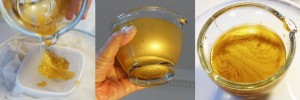Expressing the Inexpressible 2
In my previous post I looked at an historical genre of Persianate manuscript paintings of the Night Journey or Isra and Mi’raj of the Prophet Muhammad (Peace be Upon Him). Most of these illustrations date from the 15th or 16th century, and were made in the royal ateliers of Central Asia, Iran or Turkey.


One of the challenges the painters undertook was expressing the presence of the Divine – unknowable and mysterious, the closest metaphor being that of light. Elite manuscript painters serving Timurid or Ottoman rulers could draw upon an accumulated repertoire of motifs that had been assimilated into the visual grammar of painting over several centuries, gathered from diverse influences, passed down and refined over generations.
One of the most flexible and expressive of these devices came from China – the formalized cloud motif, which we see in the painting details above. Eloquent cloud curls have been adapted by colour and treatment to create a swirling plasma of pure energy and light. The imagination of the viewer is excited by the use of two shades of gold, the spiralling shapes picked out with pin-pricks to make them scintillate. The apparently chaotic undulations of the cloud curls give the impression of overwhelming bursts of cosmic energy. Through visual metaphor, the painting seeks to express the presence of God.
Chinese Cloud Curl

The Chinese Cloud Curl became part of the language of Persian art and design around the late 13th century to early 14th century during the supremacy of the Mongol Il Khanid Dynasty. The Mongol elite admired Chinese art, avidly collecting imports of ceramics, brush-paintings and textiles, which in turn influenced the artists who worked for them. This interest continued into the 15th century under the Timurid Dynasty. The image above is a detail of an artefact made under the Ming Dynasty in China, contemporary with the Timurids. This beautiful cinnabar-red laquer box is decorated with designs painted in gold, depicting auspicious dragons flying amidst cloud motifs.
The Cloud Curl motif was introduced under the Western Han Dynasty in the 2nd century B.C. It is a Daoist symbol for the mythical Islands of Penglai, where The Immortals dwell.
The 14th century Yuan Dynasty Stem Cup on the left is made of some thirty layers of pigmented laquer, deeply carved with a design composed entirely of cloud curls.
These dynamic curling shapes have been popular in Chinese art in all media, the abstraction of the design making it infinitely adaptable. Variations of the Cloud Curl have been used extensively in Persian art, invoking the four Classical elements – fire, water, rock-formations, or vaporous clouds.
This fascinating Timurid painting (above) comes from a folio of “The Wonders of Creation” by the 13th century author Al-Qazwini, recently sold at Sotheby’s auction. It depicts four Angels bearing up the throne of God. Heaven is here expressed as an illuminated roundel in an azure vault, its heavenliness emphasized by clusters of airy Chinese clouds. As a further point of interest, the Angels are identified by their symbolic heads as The Four Evangelists of Christianity: Matthew (man), Mark (Lion), Luke (bull), and John (eagle).
Cloud Painting – Early Paper-Marbling Techniques
Taking the expression of the Divine to its ultimate abstraction, I include a work of art recently gifted to me by a friend who is immersed in the Sufi practices of Turkey. Paper-Marbling emerged in the Islamic world in the late 15th century, first in Central Asia under the Timurid dynasty, from whence it spread, gaining popularity in Ottoman Turkey and the Deccan Sultanates in India. Known as Abr or Ebru in the Islamic world, the name simply means “Cloud“. The designs are achieved by scattering prepared colours onto the surface of a viscous mucilage. The drops of colour expand according to their nature on the wet surface, and successive applications of different colours modify the shapes formed by the previous scattering. Once the designs have developed of their own accord, a sheet of paper is lowered onto the viscous surface, and the pattern is transferred to the paper.
As the art of Ebru developed, artists discovered different ways of manipulating the natural movement of the colours. One of the earliest techniques is Battal, which we see above. There is minimal intervention on the movement of the colours, each successive batch of scattered drops expanding and pushing the previous blobs of colour into fantastical natural formations. The artist-philosopher works with an awareness of the esoteric symbolism of his craft, and the imagination of the viewer is stimulated – in Francesco Piani’s work we might see dragons, clouds, a shower of meteorites, or maybe an elemental cosmic genesis.
The beauty of this art form depends on natural fluid dynamics, the ordered chaos creating designs that are beyond the hand of the artist. The elemental formations inspire contemplation of the forces of nature, and ultimately, the Divine.





 "Making Masterpieces for a Prince of the Black Sheep" – my Bodleian Fellowship research blog
"Making Masterpieces for a Prince of the Black Sheep" – my Bodleian Fellowship research blog "The Book of Gold" – Gold pigment tutorial available from my Etsy shop
"The Book of Gold" – Gold pigment tutorial available from my Etsy shop
Pingback: Expressing the Inexpressible 1 | Anita Chowdry